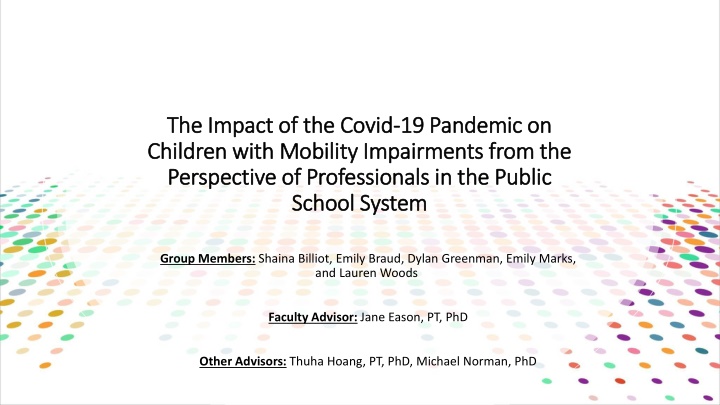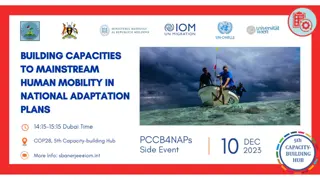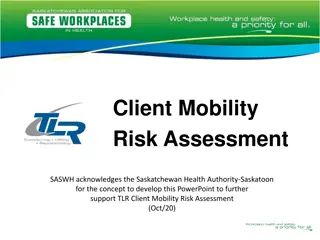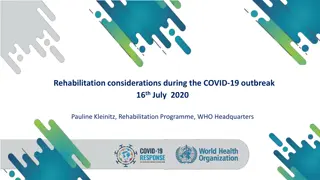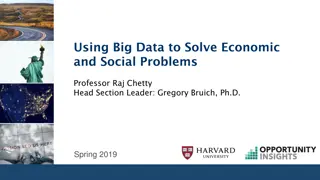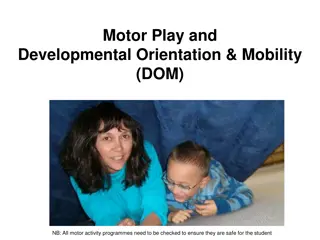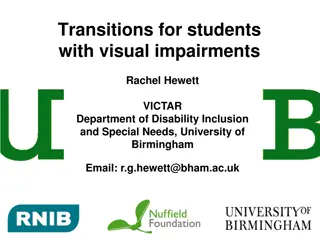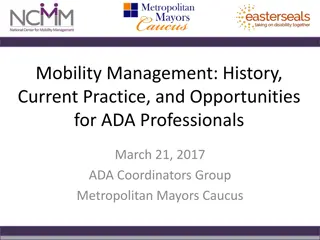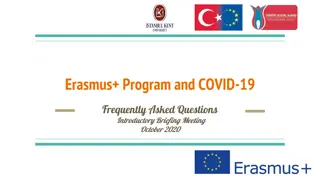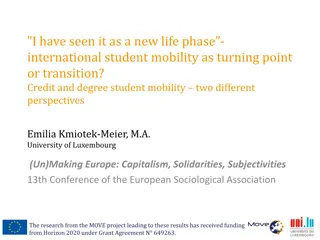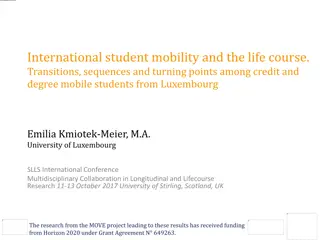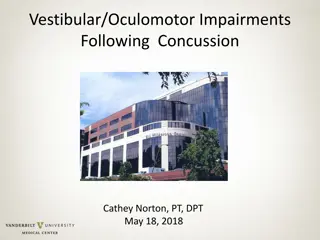Impact of COVID-19 on Children with Mobility Impairments: Professional Perspectives
This research explores the challenges faced by professionals in the public school system working with children with mobility impairments during the COVID-19 pandemic. It discusses the shift to remote learning, history of special education legislature, research questions, and more.
Uploaded on Feb 28, 2025 | 0 Views
Download Presentation

Please find below an Image/Link to download the presentation.
The content on the website is provided AS IS for your information and personal use only. It may not be sold, licensed, or shared on other websites without obtaining consent from the author.If you encounter any issues during the download, it is possible that the publisher has removed the file from their server.
You are allowed to download the files provided on this website for personal or commercial use, subject to the condition that they are used lawfully. All files are the property of their respective owners.
The content on the website is provided AS IS for your information and personal use only. It may not be sold, licensed, or shared on other websites without obtaining consent from the author.
E N D
Presentation Transcript
The Impact of the Covid The Impact of the Covid- -19 Pandemic on Children with Mobility Impairments from the Children with Mobility Impairments from the Perspective of Professionals in the Public Perspective of Professionals in the Public School System School System 19 Pandemic on Group Members: Shaina Billiot, Emily Braud, Dylan Greenman, Emily Marks, and Lauren Woods Faculty Advisor: Jane Eason, PT, PhD Other Advisors: Thuha Hoang, PT, PhD, Michael Norman, PhD
Introduction Introduction The Move to Remote Learning1-4 The COVID-19 pandemic resulted in immediate school closure impacting children with disabilities more severely than their typically developing peers Due to a higher chance of: Lower socioeconomic statuses Unfavorable childhood experiences Living in single-parent homes Rapid shift to remote services resulted in a family-centered approach to therapy Parents --> increased responsibility; proper management and use of assistive technology. Physical therapists --> proper video-based demonstration; corrective feedback APE teachers --> pre-session planning meetings with parents or caregivers
Introduction Introduction History of Special Education Legislature1, 5-8 Rehabilitation Act, specifically Section 504 1973 Individuals with Disabilities Education Act (IDEA) - 1975 IDEA Expansion 2004 Individualized Education Programs (IEP) An IEP is created uniquely for every child who receives special education and related services in a public school by parents, teachers, and school staff members Includes: performance, annual goals, special ED services, participation in state/ district-wide tests, transition services, age of majority and measure of progress The Role of Professionals in the School System 9-12 Related Services: Example: OT, PT, Speech, Audiology, and psychology Direct Services: Example: Adapted Physical Education(APE)
Research Questions Research Questions The question becomes.... How can we, as a healthcare community, overcome the challenges and adversities to treatment placed upon us during this COVID-19 pandemic? What are the experiences of professionals in the Louisiana public school system who work with children with mobility impairments during the COVID-19 pandemic?
Methods Methods Participants Physical therapists, occupational therapists, adaptive physical education teachers, special education or general education teacher Employed in Louisiana public school system Works with students who have mobility deficits Recruitment Recruitment email distributed to four school districts via local disability program administrator Interested individuals contacted a designated member of research team and was sent a demographic form All eligible participants were informed and instructed on data collection process This study was approved by the Institutional Review Board (IRB)
Methods Methods Data Collection Participant-specific responses to interview questions Semi-structured individual interview Demographic form Audio Transcription Data Analysis Descriptive statistics were used to assess participant's demographics and responses Qualitative data was analyzed using a stepwise process with coding to category and later reduce data to thematic analysis Descriptive coding was used to form 5 themes
Results Results - - Participant Demographics Participant Demographics Participant 1 Participant 2 Participant 3 Professional Role Physical Therapist Adaptive Physical Educator Physical Therapist Grade Levels Serviced K-12th K-12th K-12th Age Range of Students 4-21 years old 4-21 years old 4-21 years old Type of Classrooms Inclusive and Separate Classrooms Inclusive and Separate Classrooms Separate Classroom (SDA and ECSE) Years of Experience (In the school system) 33 years 12 years 1 year Diagnoses of Students Physical and intellectual disabilities Physical and intellectual disabilities Physical and intellectual disabilities
Results Results 1) Administrative Plan of Action 1) Administrative Plan of Action Initial response to pandemic Pause of services vs immediate transition IEP goals did not change, just the delivery of services Ensuring maintenance of academic standards Access to assistive technology
Results Results 2) Challenges 2) Challenges Schedule We had to fit them into the parents schedule, which was really hard, a lot of parents were working full time from home, and then they had to try and fit in not only academics, but they have to fit in OT, PT, speech, and APE. It's a lot just trying to work around everybody. - Participant 1 Technology Lack of hands-on treatment Equipment availability Communication
Results Results 3) Changes to Practice 3) Changes to Practice Virtual formats Adapting to services in the home environment I think we learned that it's so important to bridge that gap between what we're doing at school and what's going on at home. Because the parents do have the same goals, it might not be geared toward the academics, but their goals are the same... - Participant 1 Increased parent/caregiver education Increased flexibility required Increased amount of collaboration/co-treatments with other professionals Improved infection control upon return to in-person
Results Results 4) 4) Caregiver Response Caregiver Response Initially Frustration Increased roles/responsibilities "Now I have to be the parent, teacher, OT, PT, Speech, and you know I have a wife"- Participant 1 Diminished confidence Lack of communication Educational barriers Over Time Gained confidence Improved family dynamic Empathized with educators and professionals Understood the importance of IEPs Acknowledged the necessity for therapeutic services
Results Results 5) Student Response 5) Student Response Required to follow IEPs Dependent on factors including: Severity of the disability Home environment Access to equipment Caregiver involvement Decreased opportunities to improve mobility. A lot of kids regressed because they just didn't move. At school they're constantly transitioning. They're going from class to class, they re going from the carpet to their desk to the board. They're just moving throughout the day constantly. So, I saw a lot of regression, especially with my low tone kids, just because they didn't move. - Participant 1 Mix of progression and regression in students physical performance
Discussion Discussion Purpose: To explore the experiences of professionals in the Louisiana public school system who work with children with mobility impairments during the COVID-19 pandemic Analysis identified a multi-layered relationship
Discussion Discussion - - Administrative Plan of Action Administrative Plan of Action13 13- -16 16 Initial response Immediate closure of schools --> loss of student progression, increase in caregiver stress and burden, decreased student mobility Over time Transition to remote services --> ensure academic standards, combat regression, improve student mobility outcomes Access to assistive technology --> improve student mobility and progression toward IEP goals
Challenges17 17- -21 21 Discussion Discussion - - Challenges Limited Caregiver availability Virtual functional assessments --> decreased ability to determine functional status Limited equipment and resources --> decreased ability to understand the quality of performance of motor tasks Communication and technology --> increased distractibility of children "Some of them are running away in the background so it s like getting their sustained attention was very difficult. Also communicating with the parent like if you want them to do a certain exercise or something, getting them to do it the correct way was kind of challenging" Covid-19 pandemic intensified the barriers of children s overall physical activity participation Associated with regression of motor skills and functional mobility
Discussion Discussion - - Changes to Practice Changes to Practice18,22 18,22 Increased parental involvement in child's care and therapy Utilization of home environment Facilitate treatment plans to daily needs of students Improved infection control Return to campus includes modifications including "thoroughly sanitizing equipment on a regular basis, modified playground and lunchroom access with associate hygiene routines, modified PE activities and reduced mingling of students from different classes." Virtual vs. Hybrid vs. In-person Options of returning to face-to-face classes vs remaining virtual
Discussion Discussion - - Caregiver Response Caregiver Response23 23- -24 24 Initially Negative impact of the pandemic on caregiver mental health, well-being, and overall quality of life Personal finances, Employment Status Lack of childcare and Health of their families Wishing for normalcy "I just can't wait for it to be normal again"- Participant 2 Fear of pandemic repercussions Over Time Positive impact of the pandemic on caregiver response Satisfied with delivery of remote services Stronger bonds between caregiver/child Increased caregiver confidence More quality time with family "They sent me pictures and videos of the entire family doing the same yoga video and it's like they were having so much fun as a family doing this and I'm like yeah therapy can be fun!"- Participant 1
Discussion Discussion - - Student Response Student Response20 20- -26 26 The impact of virtual service delivery on students with mobility deficits is dependent on a variety of factors. Consistent with those recognized in the Organization for Economic Co-operation and Development s Policy Brief, including environmental factors, technology access, and caregiver support. (OCED, 2020) Our study found two additional factors Limited research on the impacts specifically on children with mobility deficits following virtual services. Our study identified data specific to students with mobility deficits, including: Regressions in functional mobility Impacts to IEP goals Opportunities that the school environment provides to remain physically active. Maintaining students' IEP standards during virtual service delivery No longer being able to provide services in an inclusive setting Creative interventions to compensate for a lack of equipment Increased difficulty meeting IEP minutes.
Limitations Limitations Geographic location South Louisiana Number of participants Variety of participants Only 2 different professional backgrounds
Suggestions for Future Research Suggestions for Future Research Expand geographic location Increase sample size Increase variety of participants Address specific progressions/regressions of students
Conclusions Conclusions Collaboration Improving collaboration with other professionals and families Communication Flexibility Adjusting working hours "Bridge the gap" Combining care at school with needs at home
1. Brandenburg JE, Holman LK, Apkon SD, Houtrow AJ, Rinaldi R, Sholas MG. School reopening during COVID-19 pandemic: Considering students with disabilities. Journal of pediatric rehabilitation medicine. 2020;13(3):425-431. doi:10.3233/PRM-200789. 2. Rao PT. A Paradigm Shift in the Delivery of Physical Therapy Services for Children With Disabilities in the Time of the COVID-19 Pandemic. Physical Therapy. 2021;101(1):pzaa192. doi:10.1093/ptj/pzaa192. 3. Chessen E. Virtually Possible: Real World Strategies for Optimizing Adapted PE Programming. Palaestra: Autism Fitness. 2021;35(1):7-10. 4. Grant C. Covid-19's Impact on Students with Disabilities in Under- Resourced SchoolDistricts. Fordham Urb. L. J. 2021;48:127-139. 5. Students With Disabilities. National Center for Education Statistics. https://nces.ed.gov/programs/coe/indicator/cgg. May 2021. Accessed June 2021. 6. Heller T, Parker Harris SK. Disability through the life course. Thousand Oaks: SAGE; 2012. https://ebookcentral.proquest.com/lib/[SITE_ID]/detail.action?docID=1016416. 7. Kohanek J. Guide to the Individualized Education Program. U.S. Department of Education. https://www2.ed.gov/parents/needs/speced/iepguide/index.html#closer. Published August 30, 2019. Accessed June 29, 2021. 8. LA. ADMIN. CODE tit. 28, Bulletin 1508, 1305 (2017). References 9. LA. ADMIN. CODE tit. 28, Bulletin 1508, 1501 (2017). 10. LA. ADMIN. CODE tit. 28, Bulletin 1508, 101 (2017). 11. LA. ADMIN. CODE tit. 28, Bulletin 1508, 1507(2017). 12. LA. ADMIN. CODE tit. 28, Bulletin 1508, 1303 (2017). 13. Viner RM, Russell SJ, Croker H, et al. School closure and management practices during coronavirus outbreaks including COVID-19: A rapid systematic review. The Lancet Child & Adolescent Health.2020;4(5):397-404. doi:10.1016/S2352-4642(20)30095-X.
14. Per E, Arun F, Verhagen Mark D. Learning loss due to school closures during the COVID-19 pandemic.Proceedings of the National Academy of Sciences. 2021;118(17):e2022376118.https://doi.org/10.1073/pnas.2022376118. doi:10.1073/pnas.2022376118. 15. Duraku ZH, Nagavci M. The impact of the COVID-19 pandemic on the education of students with disabilities in pre-university education. In: Duraku ZH. Impact of the COVID-19 Pandemic on Education and Wellbeing: Implications for Practice and Lessons for the Future. Prishtin , Kosov : University of Prishtina Hasan Prishtina Faculty of Philosophy, Department of Psychology; 2020:91-129. 16. Murphy A, Pinkerton LM, Bruckner E, Risser HJ. The Impact of the Novel Coronavirus Disease 2019 on Therapy Service Delivery for Children with Disabilities.J Pediatr.2021;231:168-177.e1. doi:10.1016/j.jpeds.2020.12.060 17. Kaur M, Eddy EZ, Tiwari D. A Survey of Physical Therapists and Occupational Therapists to Explore Practice Patterns of Pediatric Telerehabilitation during COVID-19. Archives of Physical Medicine & Rehabilitation.2021;102(10):e15-e16. doi:10.1016/j.apmr.2021.07.435. 18. Krasovsky T, Silberg T, Barak S, et al. Transition to Multidisciplinary Pediatric Telerehabilitation during the Covid-19 Pandemic: Strategy Development and Implementation.Int. J. Environ. Res. Publi Health.2021;18:1484.https://doi.org/10.3390/ijerph18041484. 19. Fergus A, Hartsook K, Smith J, Hale M, Kellar D. A Novel Physical Therapy Learning Experience in Pediatrics Via Telehealth: A Qualitative Case Analysis.Journal of Physical Therapy Education (Lippincott Williams & Wilkins). 2021;35(2):159-167. doi:10.1097/JTE.0000000000000184. 20. Szpunar M, Vanderloo LM, Bruijns B, et al. Children and parents perspectives of the impact of the COVID-19 pandemic on Ontario children s physical activity, play, and sport behaviors. BMC Public Health.2021;21:2271.https://doi.org/10.1186/s12889-021-12344-w. 21. Ostermeier E, Tucker P, Clark A, Seabrook JA, Gilliland J. Parents Report of Canadian Elementary School Children s Physical Activity and Screen Time during the COVID-19 Pandemic: A Longitudinal Study. Int. J. Environ. Res. Public Health. 2021;18:12352. https://doi.org/10.3390/ ijerph182312352. 22. Ries E. School-Based Physical Therapy in the Age of COVID-19. APTA Magazine. 2020;12(8):28-39. References 23. Cankurtaran D, Tezel N, Yildiz SY, Celik G, Akyuz EU. Evaluation of the effects of the COVID 19 pandemic on children with cerebral palsy, caregivers quality of life, and caregivers fear of COVID 19 with telemedicine. Irish Journal of Medical Science. 2021;190:1472- 1480. https://doi.org/10.1007/s11845-021-02622-2. 24. Suarez-Balcazar Y, Mirza M, Errisuriz VL. Impact of COVID-19 on the Mental Health and Well-Being of Latinx Caregivers of Children with Intellectual and Developmental Disabilities.Int. J. Environ. Res. Public Health. 2021;18(15):7971. https://doi.org/10.3390/ijerph18157971. 25. OECD (2020), COVID-19: Protecting people and societies, OCED Policy Responses to Coronavirus(COVID- 19), https://www.oecd.org/coronavirus/policy-responses/covid-19-protecting-people-and-societies-e5c9de1a/#section-d1e33. 26. Tulchin-Francis K, Stevens W, Gu X, et al. The impact of the coronavirus disease 2019 pandemic onphysical activity in U.S. children. J Sport Health Sci. 2021;10:323-332. https://doi.org/10.1016/j.jshs.2021.02.005.
